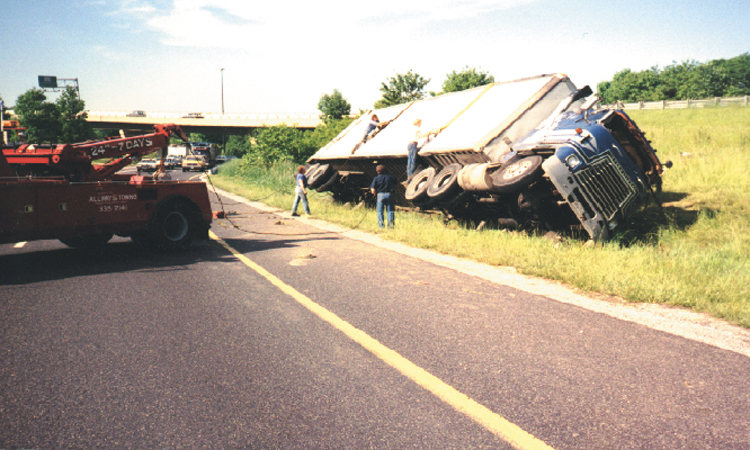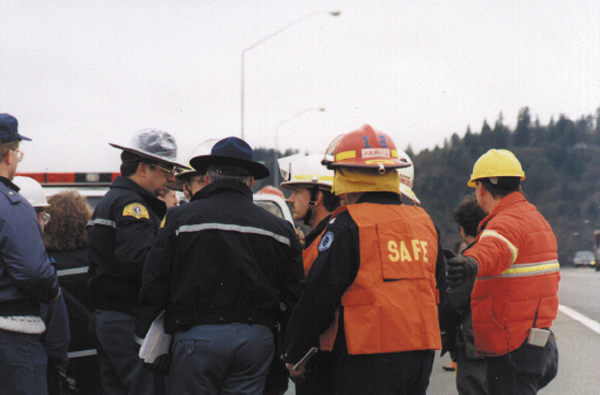| Skip
to content |
|
|
|
Traffic Incident ManagementThis publication is an archived publication and may contain dated technical, contact, and link information.Traffic Incident Management ChallengesStalled vehicles, traffic stops, highway debris, spilled loads, and crashes are examples of traffic incidents that account for about one-third of all delay due to traffic congestion on our nation's highways. Along with weather, construction, and special events, these non-recurring incidents are responsible for nearly 60 percent of delay caused by traffic congestion. Traffic congestion caused by incidents affects the safety and mobility of all travelers. Major incidents can affect thousands of vehicles in an entire highway corridor or across a major portion of an urban area. Traffic incidents cause secondary incidents that also require response from the same agencies already engaged in the primary incident. Secondary incidents are not just crashes but also include engine stalls, overheating, and running out of fuel. Approximately 20 percent of all incidents are secondary incidents.  What We've LearnedTraffic incidents are primarily public safety events. Public safety agencies, such as law enforcement, fire and rescue, emergency medical services (EMS), and other emergency management agencies are first to respond to traffic incidents. Transportation agencies usually play a secondary, but vital, support role. Private sector entities are also involved. The two most common are the towing and recovery industry and hazardous materials contractors. News and traffic reporting media will also be involved but may not be on-scene. Actually, the list of partners at a major incident can be very long and might also include environmental, health, emergency management, and agriculture agencies. These agencies all have different functions and skills needed to handle specific tasks at an incident. It should not be surprising, therefore, that these agencies have differing views on priorities at the site, how functions should be carried out, or even who has the authority to direct actions. Traffic incident management is a process that builds consensus and promotes institutional bonding through formal and informal processes to integrate multipartner on-scene operations and communications. The goal of the Federal Highway Administration (FHWA) Traffic Incident Management Program is to reduce incident delay by enabling integrated interagency operations supported by integrated interagency communications. Three major program areas are:
What We're DoingProgram and Institutional CoordinationMany public sector agencies and private sector partners are involved in traffic incident management, but it is not a core function of any agency. Coordinating the operations of many entities with conflicting priorities and functions is extremely complicated and can best be accomplished through some type of formal traffic incident management program. Partner agencies in formal programs are bound by interagency agreements and guided by a multi-agency strategic program planning process. They also have multi-year program plans or "roadmaps" to guide the budget planning process of the partner agencies. Major FHWA program initiatives to promote institutional coordination include:
On-Scene Operations Coordination Rapid response with appropriate resources to an incident and the quick clearance of that incident are, of course, the main purposes of a traffic incident management program. Effective incident clearance must achieve the seemingly conflicting goals of protecting the safety of on-the-scene responders and travelers while maximizing traffic flow past the incident. This can only be achieved by understanding, agreement, and close coordination among those in charge of their agency's resources on-scene. Responder safety has long been the major concern of public safety agencies and for good reason. The leading cause of on-duty death in law enforcement is traffic-related events, either en-route, in pursuit, or on-scene. Traffic-related events are the second leading cause of death for fire-rescue agencies. Effective positive traffic control that warns and protects both at the incident and at the end of the traffic queue behind the incident is vital. Major FHWA program initiatives in this area are:
In addition, FHWA previously supported and participated in the development of two guides to assist responders:
Communications and Technical CoordinationEfficient and rapid response, managing resources at the incident, and providing area-wide traffic control depends on the rapid exchange of accurate and clear information among the responding parties. It is vital to provide means of communicating voice, data, and video information on links that are field-to-field, field-to-center, and center-to-center. Interest is rapidly growing in integrating transportation and public safety data systems so responders can do their jobs more effectively. Major FHWA program initiatives to enhance interagency communications include:
21st Century Operations and Security Traffic Incident Management is the on-scene application of multi-agency operational procedures to achieve diverse but related activities all ending in the safe and rapid clearance of the incident scene. Traffic Incident Management requires a 24/7 emergency response operational philosophy - a normal operating mode for public safety agencies but a new and different one for transportation agencies. Large-scale natural or man-made emergencies are rare events requiring high levels of coordinated response. Experience gained from multi-agency coordination of operations and communications among the same partners for traffic incidents that occur daily provides the framework for efficient and coordinated response to major emergencies. For more information on FHWA Office of Operations activities, visit our web site at https://www.fhwa.dot.gov/operations April 2004 FHWA-OP-04-052
|
|
United States Department of Transportation - Federal Highway Administration |
Last modified: February 22, 2017 | |